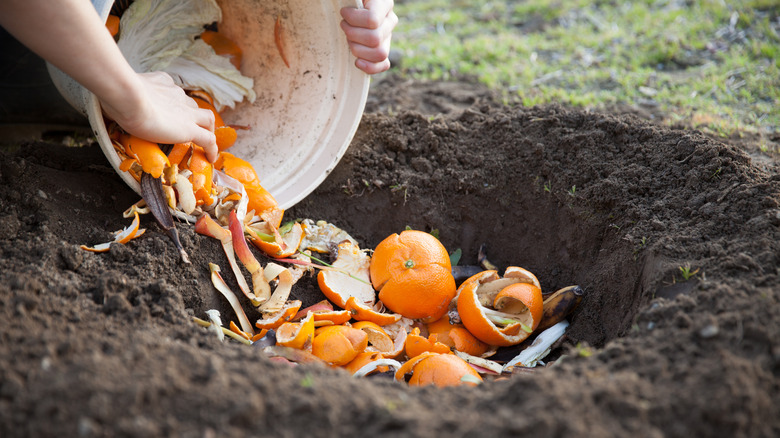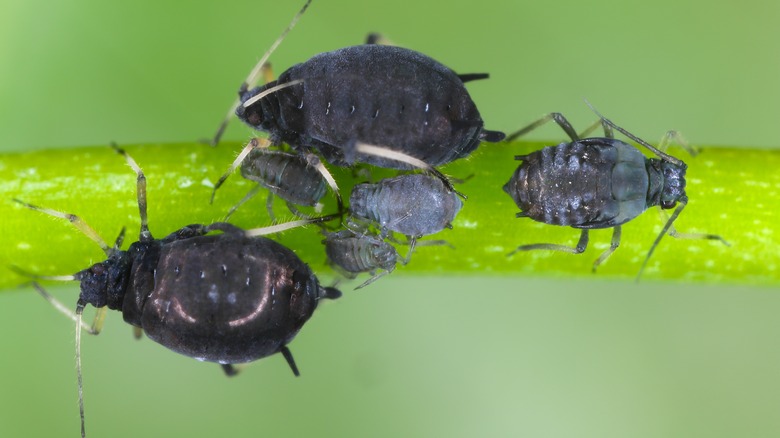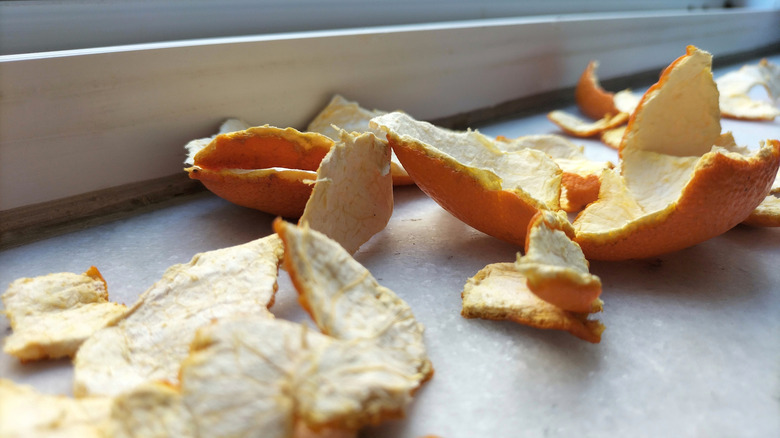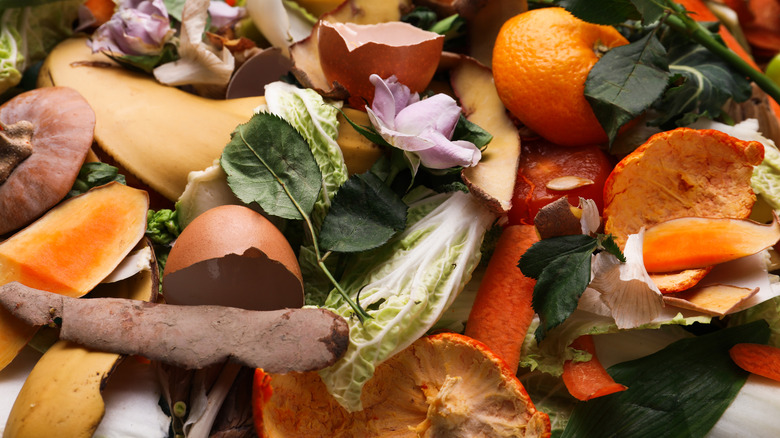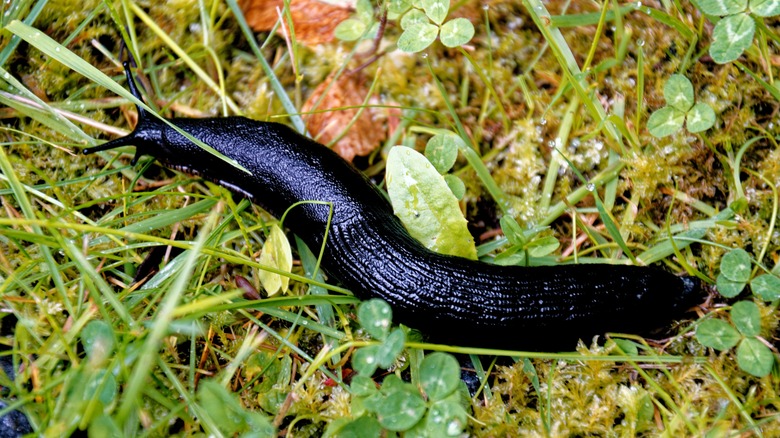12 Clever Ways You Should Be Using Orange Peels In Your Home And Garden
Do you have a love of oranges? If so, you'll be excited to discover that orange peels have a plethora of uses in the garden and around the home. In addition to the pleasant fragrance they emit, orange peels contain natural compounds that make them useful for everything from cleaning to repelling pests to adding nutrients to the soil. Instead of tossing the orange peels in the trash after your next afternoon snack, you can save the peels and repurpose them with these eco-friendly tips.
When it comes to sustainability, you'll find orange peels are as valuable as gold. Not only will reusing the peels save you money, but it's also an excellent way to reduce waste. You can harness the power of the orange peels to replace furniture polish, plant pots, garden fertilizer, and even chemical fire starters. You'll find incorporating these clever strategies a breeze, and after a while, they'll even become second nature.
To fertilize plants in the garden
One way to use orange peels in your garden is to help plants grow. The peels make an excellent fertilizer, as they add nitrogen and other important nutrients to the soil. A 2021 study published by the International Journal of Environmental and Rural Development revealed that a powder made from orange peels not only fertilized the soil, but also worked well as a natural micronutrient supplement. Another study conducted by the L.D. College of Engineering showed that orange peel powder helped decrease soil pH in soils that were more alkaline. The university also concluded that orange peel powder was best for horticultural purposes.
Before you can feed the orange peels to your plants, you'll need to dry them out and turn them into a powder. This is easily done using a food dehydrator. Simply cover the drying racks with a piece of parchment paper and then assemble the orange peels on the rack, making sure that the peels aren't touching. Bake the peels for approximately eight to 12 hours. The peels are done when all of the moisture has evaporated. To test for moisture, bend the peel backward. If it sticks to itself, it needs more time in the dehydrator. Once the peels are dry and have cooled, you can place them in a blender to convert them into a powder. Sprinkle the homemade fertilizer powder around the plants in your garden to give them a boost of nutrients.
To make a non-toxic candle
Another way to save your orange peels from just ending up in the trash is to reuse them as candles. Homemade candles are an excellent way to save money, as well as avoid the toxins that are often found in store-bought candles. Orange peel candles are a cinch to make, even if you've never attempted to create a homemade candle before. In addition to providing a romantic light to your dinner table, the candles can also be used to add a decorative touch to any mantle or coffee table.
Cut your orange in half and scoop out the fruit. Eat the fruit or toss it in a fruit salad. Take the two orange peels and fill them with oil. You can use olive oil or melted beeswax. If the center stem is still in place, you can use that as a natural wick. Otherwise, you'll need to anchor a wick into the center of the orange peel. Drip in a few drops of orange essential oil if you want to enhance the citrus scent. Olive oil orange peel candles can be used as-is; however, you'll need to wait for the beeswax to harden before you use that version of the candle.
To create a pot to start seeds
When it comes to germination, seed starter pots are very important. They offer protection from pests and weather, and are better able to provide the warm, moist conditions seeds need to grow. Instead of spending money on a set of seed starter pots, just use your orange peels. The rinds are thick enough to act as natural pots and their small size is perfect for germinating seeds. As we learned earlier, orange peels are also rich in nutrients that plants need to grow healthy and strong.
Cut your oranges in half and remove all the fruit. Each half can be used as its own pot. Fill the orange peels with a potting mix that is labeled as a "seed starting" mix. Add your seeds to the soil and water until the soil is nice and moist, but not sopping wet. Set the orange peel pots in a warm location that receives plenty of sun. Once the seeds have germinated, you can transplant them in your garden. You don't even need to remove them from the orange peel when you set them in the ground. Tip: You can also use the peels from tangerines and clementines as seed starter pots.
To make your own potpourri
If your home or office is in need of an aromatic boost, potpourri is an excellent option. It provides the air with a pleasant scent that isn't overly strong or offensive. Saving your citrus peels to make a batch of potpourri is a great way to reuse them. The citrus peels can also be combined with a few other ingredients, such as cinnamon, clove, or lavender essential oil. Potpourri can be created in a liquid, or the ingredients can be dried and set out in a decorative bowl.
To create your orange peel potpourri, you'll need a slow cooker or just a pot on the stove. Place your citrus peels inside the slow cooker or pot, making sure there are no stickers or price tags on the rinds. Add any other fruit peels that you may have on hand, such as apples and limes, and then fill the cooker or pot ¾ of the way with distilled water. Add any herbs or spices next. Rosemary, bay leaves, and anise all work well. Finish with a few drops of your favorite essential oil. Set the slow cooker or stove to low heat and let the fresh scent fill the air. To create a dry potpourri, place your fruit peels inside a food dehydrator. Once dried, set the peels in a bowl and add your desired spices and essential oils.
To deter pests from the garden
Whether you're growing vegetables or flowers, there's nothing worse than visiting pests. Some pests do more damage than others, but it's best if you can protect your garden. While there are plenty of chemical insecticides to keep pests at bay, they often aren't the best choice. Chemicals can leach into your vegetables and many of the pesticides also harm beneficial insects, such as bees. Orange peels make an excellent all-natural insect repellent without the chemicals. They also don't deter bees. Peels work as an insect deterrent because they contain a liquid called limonene, which mosquitoes, aphids, and whiteflies detest.
To use orange peels to keep pests out of your plants, you can either place the peels on the ground in and around the garden, or create a citrus spray. When setting the peels on the soil, cut them up into smaller strips first. You'll need to replace the peels often, as they are only effective when fresh. To create a citrus spray, simply boil the peels in water. After the water has been infused with the citrus, you can remove the peels and then transfer the water to a spray bottle. Spray the solution on the plants to provide them with protection. Repeat use of the spray every couple of days or after a big rainfall.
To make a firestarter for fire pits and fireplaces
Campers who create fire pits and families that heat their homes using fireplaces know that it's easier to start a fire when you have a fire starter. There's no need to resort to chemical fire starters, however, as orange peels work just as well. As long as the orange peels have been dried first, you can add them to your kindling to get a healthy fire going in no time at all.
There are several ways one can dry out a batch of orange peels to create a homemade fire starter. You can place them out in the sun, set them over the top of your wood stove, or you can use a food dehydrator. The food dehydrator will work the quickest, taking anywhere between 8 and 12 hours. If you opt for the wood stove, let the peels sit out for a full 24 hours. Setting the peels outside in the sun on a tray may take a few days, but it will get the job done. Once you have your dried peels, place them among the kindling in your fire pit or fireplace and light them up.
To create an all-natural cleaning solution
The same component within orange peels (d-limonene) that deters pests, also works as a natural cleaner. Additionally, the peels contain antibacterial properties, which work to kill germs on the surfaces you're cleaning. Creating an all-natural cleaning spray using orange peels is a cinch. Once you've completed that task, you can move on to using any leftover peels to prepare a homemade furniture polish, as the oils within the orange peels condition and shine wood.
Fill a mason jar ¾ of the way with orange peels. Add vinegar until the jar is completely full. Screw the lid on and set the jar in a pantry or cabinet that is nice and dark. Wait two weeks before retrieving the jar. Transfer the liquid from the mason jar to a spray bottle. Your orange peel cleaning solution is now ready for use. To prepare a furniture polish, pour a cup of olive oil in a mason jar. Add two drops of vanilla extract and the peel from one orange. Secure the lid and set the jar aside. Wait three days before using the polish to freshen up your furniture. A word of warning: The homemade orange peel polish should only be used on finished wood.
To form a vase for your garden flowers
Not only do orange peels make excellent seed starter pots, but they also work nicely as vases for your garden flowers. The eco-friendly vases don't cost a cent, and when filled with a small bouquet, they add a decorative touch to any indoor kitchen or outdoor patio table. The next time you're having a few guests over, consider putting together a few of these unique vases, which are sure to double as conversation pieces.
Instead of cutting your orange in half like you did with the seed starter, slice across the top. You want to use the entire peel as a vase. Scoop out the fruit carefully with a spoon. Place the orange peel in a dehydrator or set it out in the sun. You won't be able to use it as a vase until it's fully dry. Collect some fresh flowers from your garden and set them inside the orange peel vase. Add water and a little bit of sugar to the vase to help keep the flowers fresh longer. Another option is to place a small piece of floral foam at the bottom of the orange peel vase. Then press a few artificial flowers down into the floral foam. This option will last much longer than a vase of fresh flowers.
To make a bird feeder
Birds offer home gardeners a variety of benefits, including dining on plant pests and pollinating flowers. It's also extremely relaxing to sit back with a cup of iced tea and watch the birds in action from the comfort of your back porch. To attract birds to your garden, you need only create a few bird feeders out of a set of orange peels.
To create your DIY bird feeder, you'll need to cut an orange in half. Each half can be used as its own bird feeder. After removing the fruit, you'll need to decide whether you want to use the peel as-is or dry it first in a food dehydrator. The orange peel is brighter in color when left fresh, but it will be susceptible to mold and rot. If you don't mind creating a new bird feeder each week, you can leave the rind unaltered. Once your peel is ready, punch holes in two of the sides and thread a piece of twine through each hole. Use the twine to hang the bird feeder from a branch. Fill the bird feeder with wild bird seed and wait for the feathery creatures to pay your garden a visit. Tip: Push a wooden skewer through the center of the orange peel, so that birds have a place to perch when visiting the bird feeder.
To add minerals and nutrients to your compost pile
If you're looking for a way to reduce food waste, consider creating a compost pile. Compost can be worked into the soil to add important nutrients and to make the soil more fertile. When collecting food waste, it's essential that you utilize only approved foods, as certain foods must be avoided, such as meat, eggs, fish, and dairy. Orange peels and other fruit peels are all acceptable, as are vegetable peels and scraps.
Grab a bin that's at least 3 feet by 3 feet in size. Start with a layer of "brown" material, which can include raked leaves, small twigs, wood chips, soil, and animal manure. Add a "green" layer next, including all of your orange peels, food scraps, and cut grass. Repeat alternating the layers, ending with a brown layer on top. Water the pile and keep it moist. Turn the pile weekly until the compost is ready for use. This will take a few months, as orange peels themselves take six months to fully decompose.
To trap slugs
If you come out to your garden in the morning and spot a bunch of holes in the leaves of your plants, as well as a trail of slime, you have a slug infestation. Since slugs are able to lay as many as 80 eggs at once, you'll need to take quick action to remove the slugs from your property before they multiply. One way to accomplish this task is to trap the slugs using leftover orange peels.
When dining on your next orange, make sure you cut it in half. The dome-shaped peel can be turned upside down to provide slugs with a hiding place. Follow the trails of slime to uncover the slugs' hideout. If you can't find the hideout, just place the orange peels in areas the slugs have been seen visiting. Slugs come out at night, so you'll need to wait until morning to check the trap. Collect the slugs while wearing a pair of gloves, and then either dispose of them in a bucket of soapy water or a pot of boiling water. If you have chickens, you can let the chickens have the slugs as a tasty snack.
To create DIY ornaments
An exciting way to help encourage children to reduce waste and repurpose items is to guide them in creating ornaments using orange peels. Kids can snack on the oranges first and then turn the peels into everything from a mushroom to a star to a cute wreath. The ornaments can be used at Christmas time, as a way to celebrate a special event, or they can be given as a thoughtful gift.
Place the orange peels on a cutting board. Give children small cookie cutters to cut shapes out of the peels. If you're feeling a bit creative, you can use an X-acto knife to cut your own designs, but this knife is too sharp and dangerous for kids. Once you have the ornament cut out, punch a hole in the top and slide a piece of string through the hole. The string should be long enough to create a loop that will fit over a nail or a Christmas tree branch. Tie a knot at the end of the string and hang the ornament. If you'd like to make a mushroom, you'll need to cut an orange in half and use that peel as the head of the mushroom. Paint it red with white spots. Use a hot glue gun to attach a small stick underneath to act as the stem. Press a metal hook down into the top center of the peel and your mushroom is ready for hanging.

